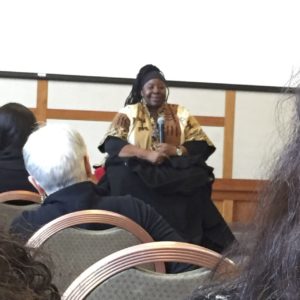
Do you laugh when you hear “Knit-In”? Let me call you in.
 It was my lucky day. I attended Local Environmental Action 2018, where keynote speaker Loretta Ross emphatically (in her folksy way) made her case for all aspects of human rights. Loretta would like to see a culture where we can “call in” and build connections rather than “call out” and isolate people.
It was my lucky day. I attended Local Environmental Action 2018, where keynote speaker Loretta Ross emphatically (in her folksy way) made her case for all aspects of human rights. Loretta would like to see a culture where we can “call in” and build connections rather than “call out” and isolate people.
In group sessions, I marveled at the different paths life leads us and heard motivations for attending the Conference. International approaches to reducing our carbon footprint and adapting to the change inspired me to keep moving forward. Strategies learned at a session inspired by research from NNOOCI give me a framework to communicate in ways that can build consensus. I even won something in the silent auction!
At the closing keynote, Mariama White-Hammond encouraged everyone to protect our progress, build connections in our community and envision a future that will result in a more equitable and sustainable future.
It was an inspiring and tool building day.
There was a moment when my face wrinkled: When Carol Oldham praised the efforts of Jane Palmer leading a knit in to protest a proposed pipeline in VT, she had to pause while many in the audience giggled. Oh, dear, not again.
Does “knit in” make you laugh? Let me call you in (a chance practice what I learned).
I cannot deny the stereotype of knitting as an activity of the elderly women, which is somehow not perceived as cool as… Beyoncé or Juan Manuel Santos. Not that many years ago, knitting was a necessary activity done by all ages. In the US, knitting and protest trace back to the Revolutionary War. While the decline in handwork was dramatic in the 1950s and 60s, activity rebounded beginning in the 1970’s. In this millennium, motivation and passion for not just knitting, but all kinds of creation are growing in a new way.
Even Stephen Colbert half heartedly recognizes this, making a short attempt to learn to knit on air.
Mariama encourages gestation of a new vision that will include everyone. Perhaps the 2001 Manifesto of the Revolutionary Knitting Circle provides a framework for local environmental action.
We hold that all communities should have the means necessary to meet every essential need of their own people.
To that end, the Revolutionary Knitting Circle calls upon people everywhere to take up the struggle through the tools of local production. We shall bring forth not only our voices raised for global justice, but we shall rise together, with the tools to liberate local communities from the shackles of global corporatism.
By sharing in the skills and resources of our communities, we shall become free to cast off dependencies on global trade for our subsistence. In so doing, we shall all be able to enter fairly into meaningful and equitable trade of not only goods, but also those cultural intangibles that are necessary if we are to bring about understanding, justice and peace to truly enrich our individual lives and our communities.
I do not know exactly why Jane Palmer chose to knit at Vermont Gas. Perhaps, like me, she enjoys making each moment productive and doesn’t leave the house without her knitting. Perhaps the rhythmic, repetitive movement of their hands calmed everyone’s minds. Perhaps they were creating an installation to raise awareness of the proposed pipelines’ pathway. Whatever their motivation, knitting is part of their activism tool box.
You, too, can learn to knit. I’d be happy to teach you, and lead classes at Lucky Cat Yarns. If you’re not nearby, find your local yarn shop, pick up a book at your library or look online for videos to begin your journey.
Thank you for your consideration.


